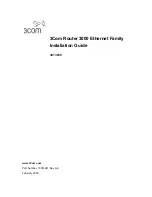
25
CHAPTER 3
INTRODUCTION TO CLI
3.3 CLI Modes
The Command Line Interface (CLI) is mainly divided into four basic modes
;
these are User mode, EXEC mode,
Config mode and Config Interface mode. After entering the username and password, you start from the EXEC mode
(prompted with “#”). The commands available in User mode and EXEC mode are limited. For more advanced
configurations, you must enter Config mode or Config Interface mode. In each mode, a question mark (?) at the
system prompt can be issued to obtain a list of commands available for each command mode. The following table
provides a brief overview of modes available in this device.
Mode
Prompt
Enter Method
Exit Method
User mode
>
enable
disable
EXEC mode
#
Enter authorized
username and
password
Exit, logout
Global Config
Mode
(config)#
Enter “configure
terminal” after “#”
End, exit, do logout
Config Interface
Mode
(config-if)#
Specify interface,
interface type and
number after
(config)#
End, exit, do logout
3.4 Quick Keys
There are several useful quick keys you can use when editing command lines.
Keyboard
Action
?
Issue “?” to get a list of commands available in the current
mode.
Up arrow key
To view the previous entered commands.
Down arrow key
To view the previous entered commands.
Tab key
To complete an unfinished command.
3.5 Command Syntax
Commands introduced in this user manual are written using the coherent symbols and easy-to-understand syntax
and style. Although users can issue Help command to complete a desired command in CLI, it is useful to understand
frequently-used symbols and syntax conventions. The following table lists the syntax conventions used in this user
manual together with an example.
Example: (config-if-vlan)# ip address { { <address> <netmask> } | { dhcp [ fallback <fallback_address>
<fallback_netmask> [ timeout <fallback_timeout> ] ] } }
Symbol
Function
Example
Explanation
< > (Angle
bracket)
Enter a value, alphanumeric
strings or keywords.
<address> <netmask>
Enter IP address and subnet
mask.
[ ]
(Square
bracket)
This is an optional parameter.
[ fallback <fallback_address>
<fallback_netmask> [ timeout
<fallback_timeout> ] ]
Fallback parameter is an
optional item.
{ } (Curly
bracket)
A curly bracket has the
following two functions:
1.
If there are more than two
options available, a curly
bracket can be used to
{ { <address> <netmask> } |
{ dhcp [ fallback
<fallback_address>
<fallback_netmask> [ timeout
<fallback_timeout> ] ] } }
At least specify one option
to complete the command.
Summary of Contents for MSW-4424C Series
Page 1: ...1 MSW 4424C MSW 4424CS L2 Gigabit Carrier Ethernet Switch ...
Page 382: ......
















































